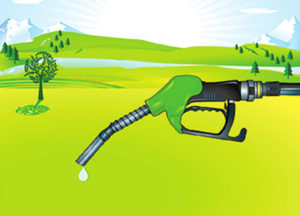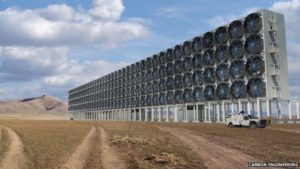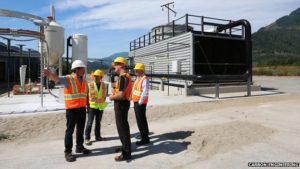Diesel Fuel Extracted From The Air Could Be A Game Changer
 Technology is constantly evolving. It truly is an exciting time to be alive more than any other time in history. Two companies in Germany and Canada are making waves with something from science fiction: making diesel fuel out of thin air!
Technology is constantly evolving. It truly is an exciting time to be alive more than any other time in history. Two companies in Germany and Canada are making waves with something from science fiction: making diesel fuel out of thin air!
These two firms are capturing CO2 from the air and finding innovative ways to process and sell it.
German company, Audi/Sunfire, produced its first pilot test batch of e-diesel in April and it went off without a hitch. The German government is all on board hoping this technology will be the future of energy in Europe. To prove the diesel fuel worked the Federal Minister of Education and Research, Johanna Waka, put a couple of liters in her car to celebrate the crowning achievement. And guess what!? The diesel power car started right up without incident.
Canadian company, Carbon Engineering, is also banking on this technology for the future. The firm has just build a plant to pull one to two tons of carbon dioxide from the air on a daily basis. This quantity of CO2 can be turned into 500 liters of diesel fuel. Concept Diesel Air Extraction Plant
Concept Diesel Air Extraction Plant
The process is rather simple in theory. The chemistry behind the feat goes like this: split water into hydrogen and oxygen atoms via electrolysis, add the separated hydrogen to CO2 to make carbon monoxide and water, then lastly build more hydrogen atoms to build up the hydrocarbon chains. The chemical process of extracting CO2 from the atmosphere isn’t exactly new, with the last part of the equation going back to the 1920s and coined as the “Fischer-Tropsch Process”. However, only now has this technology become efficient and affordable to do it on a wide scale basis. The system does require electricity but if the plants use renewable electricity they can produce diesel fuel that is carbon neutral. Once the fuel is burned in an engine the only CO2 that returns to the atmosphere is same that was taken in the first place. The entire system is a closed loop. Fossil fuels, on the other hand, add a surplus amount of CO2 back to the atmosphere.
According to Adrian Corless, CEO at Carbon Engineering, the biggest technological challenge has been keeping the high-temperature furnaces going on a long-term basis. However, these challenges are being resolved one issue at a time. Carbon Engineering Test Plant
Carbon Engineering Test Plant
The biggest win at Carbon Engineering has been the innovation of solid calcium carbonate pellets that can be easily washed and dried. The pellets are heated to 800-900C in the furnace where they release a pure stream of CO2. The burn-off of calcium oxide can be fed back into the first air capture stage making an efficient system which is cost effective. It is impressive technology which Carbon Engineering hopes will propel them as an industry leader in alternative energy.
According to the US National Oceanic and Atmospheric Administration (NOAA) the highest concentration of CO2 in the air reached 400 parts per million in 2012-2013 and June 2014 - June 2015 was the warmest year on record.
Besides diesel fuel there are other options for selling captured CO2 on the open market. A Swiss company called Climeworks sees the potential of selling captured CO2 to carbonated drink bottlers in Africa, Japan and various hard to reach islands. Setting up local bottling air pressurization plants could lower transportation costs. The expense of compressing, liquefying and shipping CO2 is up to 10 times more expensive in remote locations across the globe.
There are already large streams of concentrated CO2 being produced right now from natural gas and coals power plants that contain anywhere from 2.5% - 15% CO2 respectively. The question is why go through the process creating CO2 from water when it already exists in mass quantities and easier to extract? The answer is that it isn’t cost effective. There are a lot of Sulphur and other molecules in boiler gas that is difficult to purify out. It is simply easier and less complex to start from a pure CO2 form than with a multitude of other gases. Climeworks CO2 Extraction Technology
Climeworks CO2 Extraction Technology
E-Diesel could, one day, compete with regular diesel. Sunfire estimates that e-diesel will sell for €1.5 per liter. However, in the United States that equates to $6.38 per gallon making it not economically feasible with regular diesel. The current price of diesel in the UK is €1.19 per liter. A lot of what sets the price of fuel depends on government policy. The actual price of fuel can be as low as 35% of what we actually pay at the pump. The rest of what makes up fuel costs include fuel duty tax, value added tax and the retailer’s profit margin.
It is still unclear whether or not certain fuel taxes will be applied to alternative fuels or whether there will be incentives from various governments to promote alternative energy sources. Currently in the US and UK there are initiatives to reduce greenhouse gas emissions via cleaner technologies.
Overall it is truly the cost of electricity which will make or break e-diesel. It takes a lot of energy to split water into hydrogen and carbon initially. Assuming this electricity will come from solar or wind power; this process is currently not viable on a wide scale basis until prices of solar panels comes down. In the past two or three years the cost of renewable technology has dropped dramatically – especially solar panels but still has some way to go.
Dr. Paul Fennell from the Imperial College of London stated that you can convert fuel for your vehicle at about 13% efficiency. If you compare that with taking electricity and powering an electric vehicle that can be done at about 80% efficiency.
There are currently hundreds of millions of diesel vehicles already on the road which could be very favorable for e-diesel fuels once the cost of solar technology comes down. E-diesel could be used in diesel vehicles today vs. electric or hydrogen based vehicles. With electric and hydrogen there is still very little infrastructure to support these vehicles on a large scale. Diesel stations and engines could make the swap to clean diesel seamlessly.
Both Carbon Engineering and Climeworks says that the technology is scalable and will be very easy to upgrade to larger scale projects. The US Naval Research Laboratory is interested in using e-diesel to fuel ships.
Only time will tell what the future may hold for e-diesel but it sure is an interesting technology that could compete with other renewable sources of energy without the need for a change in support infrastructure.




